by Cora Ann Johnston
Get ready
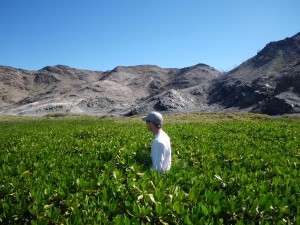
Researcher Mike Lehmann makes his way through dwarf-form mangroves in the Gulf of California. (C. Johnston)
As you approach stands of mangroves in Florida, you’re likely to notice a few things. They form expansive forests along protected seashore (usually in lagoons and estuaries) that often grow thick and tall overhead, providing welcome shade where the three species (black, white and red) intermingle. In the cool of their shade, they are clearly teeming with life; the constant pop of snapping shrimp ricochets around their oyster- and barnacle-encrusted roots while crabs and insects scurry along their branches.
These mangroves are different. There are no scurrying crabs or snapping shrimp or prominent rocks of oysters. Most of the insects have gone inside; their only traces are burrows and cocoons made in the safety of stems and rolled leaves. The blinding sun and gusty wind make it starkly obvious that the shady, protective canopy is only waist-high. The cactus on the rocky slope in the background gives it away: These mangroves are in Baja California, Mexico.
The purpose
Over the past two years, a group of Smithsonian-associated researchers have joined lead researcher Dr. Ilka “Candy” Feller’s ongoing mangrove research in order to study every possible aspect–from pollinators to nutrient limitation to wetland habitat creation–of mangroves along the Atlantic coast of Florida. The goal is to understand how, why and to what effect tropical mangroves are expanding northward into the historically grass-dominated temperate range. But mangrove expansion is a global phenomenon, and to understand a global phenomenon, you have to go global. So in mid-November, Dr. Feller and a gaggle of fellow researchers followed the 30 degrees latitude line west across North America to check out the parallel mangrove frontier along the Pacific coast. Luckily, that drops you smack in the infamous land of fish tacos: Baja California, Mexico.
Dropping into Baja in search of mangroves isn’t as easy as it sounds, so we prepared with help from both sides of the border. From navigating the Mexican peninsula to prioritizing and accessing survey sites, we relied on advice and help from Dr. Mike Osland (USGS), Chris DiVittorio (UC Berkeley), Dr. Octavio Aburto-Oropeza (Scripps), Dr. Sharon Herzka (Centro de Investigacion Cientifica y de Educacion Superior de Ensenada), and Dr. Marlene Manzano (Universidad Autonoma de Sinaloa). Dr. Manzano’s graduate student, Francisco Flores Cardenas, joined us in Baja so that we could compare and share research methods while receiving help along the way.
What we found
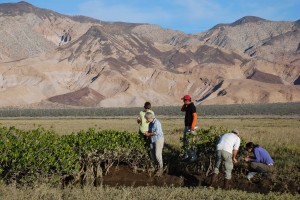
The research crew gets to work on a small stand of mangroves in a salt marsh in Bahia de Los Angeles. (L. Simpson)
Outfitted with boots, rulers, notebooks, and curious minds, we set out to get to know the mangroves of Baja. We did not set up major experiments. We did not take extensive collections. We were there to take rapid but diverse observations just to get a sense of the system. Remember the waist-high canopy and utter lack of crabs mentioned above? Those are important things to know before delving any deeper. Dr. Feller and her collaborators have studied mangroves all over the world, so we can infer a lot from a few quick observations. That stunted canopy? A sure sign of nutrient limitation, which isn’t surprising given the desolate, cactus-spotted rocky slopes around us. Even these shrunken mangroves are by far the greenest part of the landscape. You can see them from satellite images, and their shocking greenness is helpful when bumping along a dirt road in the middle of nowhere in Mexico–it’s like having someone shout “Mangroves, ho!” right in your ear.
Over the course of a week, we zigzagged across the narrow peninsula, conducting rapid assessments of flora and fauna along the mangrove frontier on both the Pacific coast and the western Gulf of California. Some of our most striking observations were also the most apparent:
(1) The mangrove frontier is pushed somewhat farther south along the Pacific, likely because the steep, wave-beaten high energy shorelines simply make for poor mangrove habitat. However, unlike in Florida, we did find a few salt marshes tucked into protective lagoons that show no signs of mangrove establishment, despite apparently perfect conditions.
(2) Northernmost mangrove stands in Baja California totally lack black mangroves (of the genus Avicennia, famous for their emergent “snorkel roots” or pneumatophores), which lead the frontier of mangrove expansion in Florida. The Baja frontier is strictly red and white mangroves (genera Rhizophora and Laguncularia, respectively). The leaf scars on some suggest that a knee-high tree may be a decade old. Though diminutive, these mangroves are not new, and this dwarf growth form can be found throughout the world.
(3) The absolute lack of tree crabs was also startling, since the same crabs–found in both the Atlantic and Pacific–are hyperabundant along the mangrove frontier in Florida.
Now what?
Heads down, working steadily, we felt right at home in the mangroves. It was mostly the quick glances over our shoulders that sent us reeling with the oddity of our surroundings. Leaf for leaf, root for root, the mangroves in Baja are not so different from those more familiar stands along the Atlantic coast. However, we saw enough to leave our heads swimming with questions. Which nutrients are limiting? Why the lack of black mangroves? Why the uninvaded marshes? Where are the crabs? Who takes their place? How long have these trees been established? We’ve returned to East coast headquarters with fresh data, burning questions, and high hopes of returning to Baja California to explore more of Mexico’s Pacific mangrove frontier.
Cora Ann Johnston is a doctoral candidate at the University of Maryland. This exploratory research was conducted by I. Feller, E. Dangremond, K. Cavanaugh, L. Simpson, M. Lehmann, F. Cardenas, and C. Johnston under the auspices of a National Science Foundation MacroSystems grant.
(Macrosystems biology – (noun) research on biological systems on regional to continental scales)

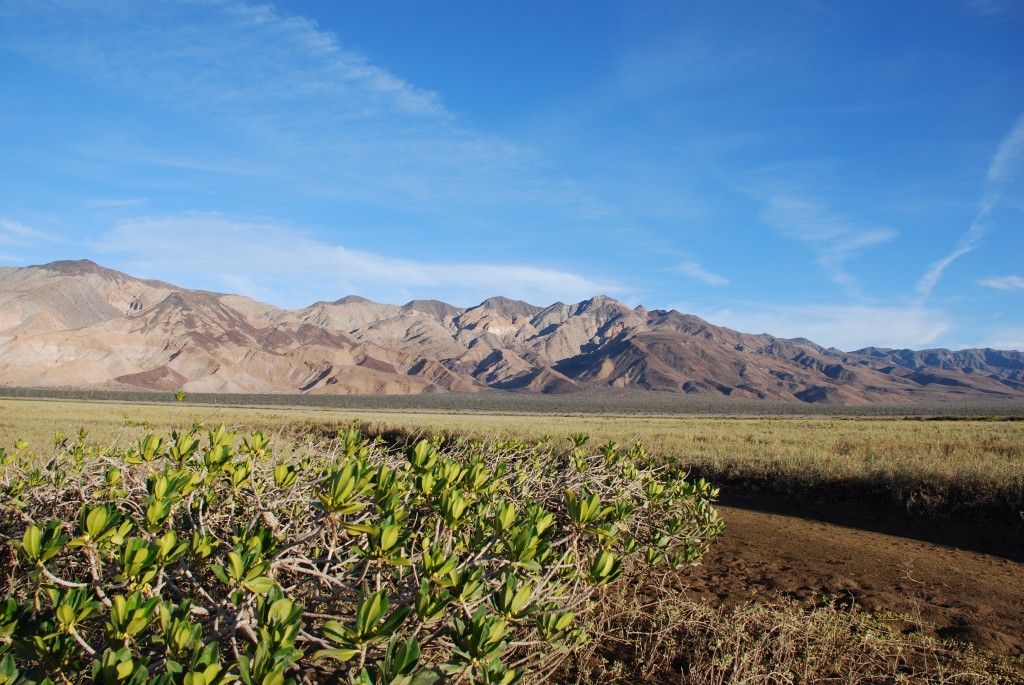
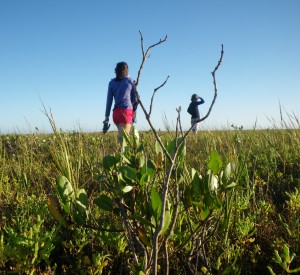
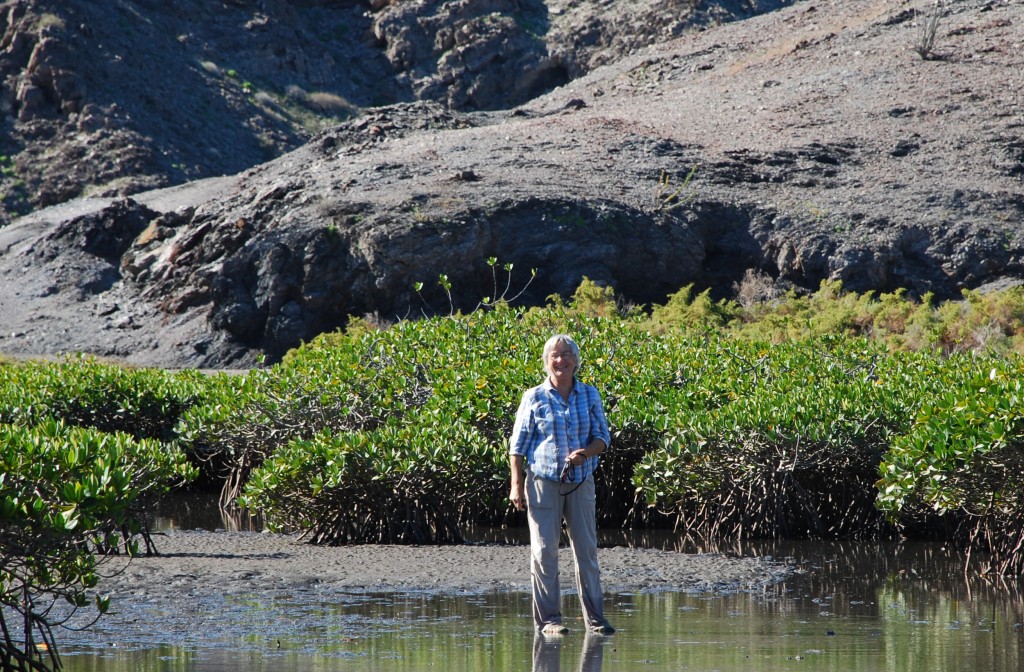

Love the research Im looking forward to the answers on these mangroves , fascinating!
Perhaps I can help somewhat. In 1973, I led a team to survey the coastal wetlands of Baja California. We visited most of the inlets/bays and made inventories of the saltmarsh & mangrove vegetation. We have photos of the sites. On returning to some sites this year, about 40 years later, I found huge losses and a major downsize of magrove heights at San Carlos and Pta Chale. I was shocked at the changes and would like to try and detemine how much is climate change (higher salinity; more storms) vs second growth after clear-cutting.
Nice reading. Very interesting. I found this site after looking at some other Florida mangrove photos. Makes me curious to know what kind of creatures live in those there.
In Feb, 2014 I paddled through some extensive mangroves outside Adolfo Lopez Mateos. Fascinating ecosystem, particularly when placed in the Sonoron Desert. I’m interested to keep abreast of any botanical work taking place in Baja…